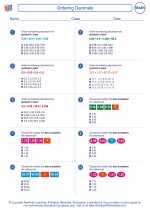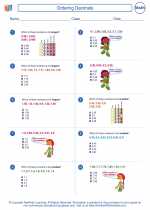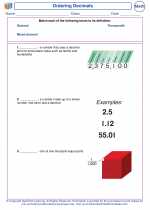Ordering Decimals
When ordering decimals, we arrange them from the smallest to the largest number, or from the largest to the smallest number. To do this, we compare the place values of the digits in the decimals.
Study Guide
- Understand Place Value: Decimals are based on place value, just like whole numbers. The first digit to the right of the decimal point is in the tenths place, the second digit is in the hundredths place, the third digit is in the thousandths place, and so on.
- Compare the Whole Numbers: If the whole numbers are different, start by comparing the whole numbers before the decimal point. The decimal with the smaller whole number is the smaller decimal.
- Compare the Decimal Parts: If the whole numbers are the same, compare the decimal parts by looking at the digits in the tenths, hundredths, thousandths, etc. Start with the leftmost digit and compare them until you find a difference. The decimal with the smaller digit in that place value is the smaller decimal.
- Use a Number Line: You can also use a number line to visualize the ordering of decimals. Plot each decimal on the number line and compare their positions to determine the order.
Examples
Let's look at a few examples to illustrate how to order decimals:
Example 1: Order the decimals 0.75, 0.6, 0.9
First, compare the whole numbers before the decimal point. Since they are all 0, we move to the decimal parts. The tenths place is the first place where the decimals differ, so we compare the tenths digit. 0.6 is smaller than 0.75, so 0.6 comes first. Then, we compare 0.75 and 0.9. 0.75 is smaller than 0.9, so the order is 0.6, 0.75, 0.9.
Example 2: Order the decimals 3.25, 3.5, 3.15
Start by comparing the whole numbers, which are all 3. Then, compare the tenths and hundredths places. 3.15 is smaller than 3.25. Next, compare 3.25 and 3.5. 3.25 is smaller than 3.5. So, the order is 3.15, 3.25, 3.5.
By following these steps and practicing with various examples, you can become proficient in ordering decimals.
[Ordering Decimals] Related Worksheets and Study Guides:
.◂Math Worksheets and Study Guides Fifth Grade. Ordering Decimals

 Worksheet/Answer key
Worksheet/Answer key
 Worksheet/Answer key
Worksheet/Answer key
 Worksheet/Answer key
Worksheet/Answer key
 Worksheet/Answer key
Worksheet/Answer key
 Worksheet/Answer key
Worksheet/Answer key
 Worksheet/Answer key
Worksheet/Answer key
 Worksheet/Answer key
Worksheet/Answer key
 Vocabulary/Answer key
Vocabulary/Answer key
